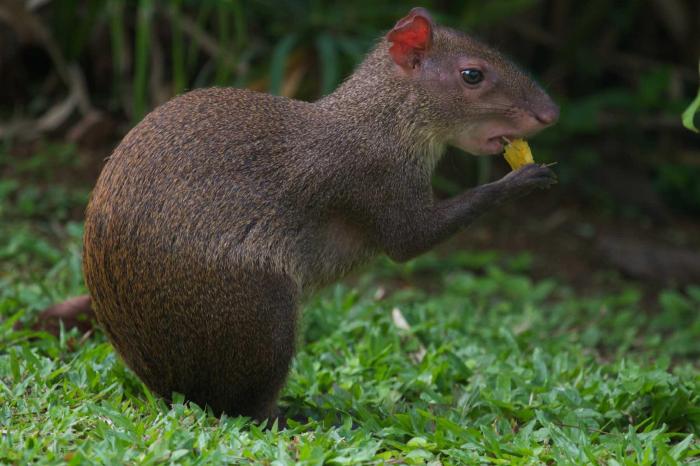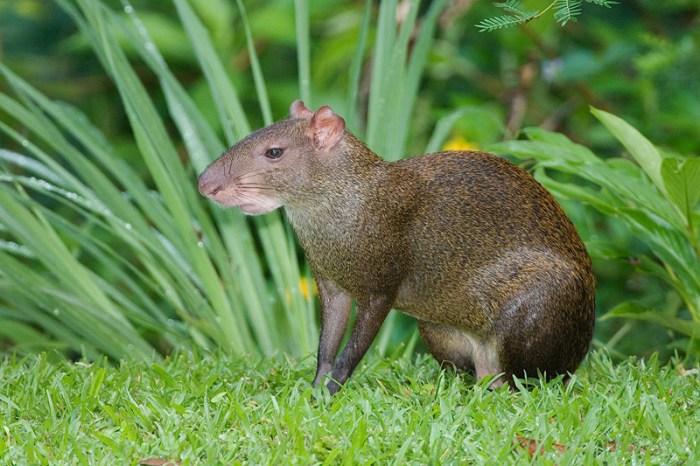Keystone species in amazon rainforest – Keystone species in the Amazon rainforest play a pivotal role in maintaining the intricate web of life within this vital ecosystem. These organisms, despite their often small size or population, exert a disproportionately large influence on the stability and functioning of the rainforest.
From seed-dispersing birds to apex predators, keystone species perform essential ecological functions that ripple through the entire food chain. Their loss or decline can have cascading effects, disrupting the balance of the ecosystem and threatening the survival of countless other species.
Definition and Significance of Keystone Species
Keystone species are organisms that have a disproportionately large impact on their ecosystem relative to their abundance. They play critical roles in maintaining the structure and function of ecosystems, and their removal can have cascading effects on the entire community.
In the Amazon rainforest, keystone species perform a variety of ecological functions, including:
- Pollination: Keystone pollinators, such as bees and bats, facilitate the reproduction of many plant species, ensuring the survival of these plants and the animals that depend on them for food and shelter.
- Seed dispersal: Keystone seed dispersers, such as birds and monkeys, distribute seeds throughout the rainforest, helping to maintain genetic diversity and prevent the loss of plant species.
- Prey regulation: Keystone predators, such as jaguars and harpy eagles, regulate populations of prey species, preventing overgrazing and maintaining the balance of the ecosystem.
Examples of keystone species in the Amazon rainforest include:
- Fig trees ( Ficusspp.): Fig trees provide food and shelter for a wide range of animals, including bats, birds, and monkeys. Their fruit is also an important source of food for many animals during the dry season.
- Army ants ( Ecitonspp.): Army ants are nomadic predators that form massive colonies. They consume large quantities of insects and other small animals, helping to control populations of these organisms.
- Giant otters ( Pteronura brasiliensis): Giant otters are apex predators that play a key role in regulating fish populations in the Amazon River and its tributaries.
Keystone Species in the Amazon Rainforest: Keystone Species In Amazon Rainforest

The Amazon rainforest is home to a vast array of keystone species, which play vital roles in maintaining the ecosystem’s balance and functioning. These species have disproportionately large effects on their communities relative to their abundance, and their removal or decline can have cascading effects throughout the ecosystem.
Types of Keystone Species in the Amazon Rainforest
Keystone species in the Amazon rainforest occupy a wide range of ecological niches and perform diverse functions. Some examples include:
- Fig trees (Ficusspp.) : Fig trees provide food and shelter for over 1,000 species of animals, including birds, bats, and monkeys. Their fruits are a major food source for many frugivores, and their hollow trunks create nesting sites for various animals.
- Leaf-cutter ants (Attaspp.) : Leaf-cutter ants are essential for nutrient cycling in the rainforest. They cut and transport leaves to their underground nests, where they are used to grow a fungus that serves as their primary food source. Their activities aerate the soil and disperse seeds, benefiting other plant species.
- Harpy eagles (Harpia harpyja) : Harpy eagles are apex predators that play a crucial role in regulating populations of large mammals, such as monkeys and sloths. Their presence helps maintain the balance of the ecosystem by preventing overpopulation of these herbivores.
- Understory birds: Understory birds, such as antbirds and woodcreepers, are important for insect control. They consume large numbers of insects, including pests that can damage plants and spread diseases.
Interdependence of Keystone Species
Keystone species in the Amazon rainforest are highly interdependent on each other and other organisms in the ecosystem. For example, fig trees rely on bats and birds to disperse their seeds, while leaf-cutter ants provide nutrients to the soil, which benefits plants that support understory birds.
Harpy eagles depend on understory birds to flush out prey, and understory birds benefit from the protection provided by the presence of harpy eagles.
The removal or decline of any one keystone species can have significant consequences for the entire ecosystem. For instance, if fig trees were to disappear, many frugivores would lose a major food source, leading to population declines and potential extinctions.
Similarly, if harpy eagles were to become extinct, populations of large mammals would increase, which could lead to overgrazing and damage to the rainforest’s vegetation.
Impacts of Keystone Species Loss
The loss of keystone species can have severe and far-reaching consequences for the Amazon rainforest ecosystem. Keystone species play vital roles in maintaining the stability and functioning of the rainforest, and their absence can trigger cascading effects that disrupt ecological processes and harm other species.
One of the primary impacts of keystone species loss is the disruption of food webs. Keystone species are often apex predators or top herbivores, and their removal from the ecosystem can lead to an increase in the populations of their prey.
This can have a domino effect, as the increased abundance of prey species can lead to overgrazing of vegetation and a decline in plant diversity.
Cascading Effects of Keystone Species Loss
- Disruption of food webs:Keystone species are often apex predators or top herbivores, and their removal from the ecosystem can lead to an increase in the populations of their prey. This can have a domino effect, as the increased abundance of prey species can lead to overgrazing of vegetation and a decline in plant diversity.
- Habitat degradation:Keystone species can play important roles in maintaining the physical structure of their habitats. For example, beavers create dams that create wetlands, which provide habitat for a variety of other species. The loss of keystone species can lead to the degradation of these habitats, which can have negative impacts on the entire ecosystem.
- Loss of ecosystem services:Keystone species can provide important ecosystem services, such as pollination, seed dispersal, and nutrient cycling. The loss of keystone species can lead to a decline in these services, which can have negative impacts on the entire ecosystem.
Historical and ongoing events provide evidence of the devastating impacts of keystone species loss. For example, the decline of wolves in North America led to an increase in the populations of deer, which overgrazed vegetation and caused widespread damage to forests.
Similarly, the loss of sea otters in the Pacific Ocean led to an increase in the populations of sea urchins, which overgrazed kelp forests and caused a decline in marine biodiversity.
Conservation and Management Strategies

Conserving keystone species in the Amazon rainforest presents multifaceted challenges and opportunities. To safeguard these critical species, a comprehensive approach is essential, encompassing habitat protection, sustainable land use practices, community involvement, and innovative monitoring and protection technologies.
Habitat protection is paramount for keystone species conservation. Establishing and effectively managing protected areas, such as national parks and reserves, provides secure habitats for these species. Additionally, implementing sustainable land use practices, including controlled logging, responsible mining, and agroforestry, can mitigate habitat degradation and fragmentation.
Community Involvement
Engaging local communities in keystone species conservation efforts is crucial. Empowering them through education, training, and participatory decision-making ensures that conservation initiatives align with local knowledge and needs. Community-based monitoring programs can also provide valuable data on species populations and habitat health.
Innovative Approaches and Technologies, Keystone species in amazon rainforest
Advanced technologies play a significant role in monitoring and protecting keystone species. Remote sensing techniques, such as satellite imagery and drones, enable researchers to track species movements, identify habitat changes, and assess population densities. Additionally, acoustic monitoring systems can detect and monitor vocalizations of keystone species, providing insights into their presence and abundance.
Research and Monitoring
Research on keystone species in the Amazon rainforest has made significant progress in recent years. Studies have identified and characterized numerous keystone species, including apex predators, pollinators, and seed dispersers, and have explored their roles and interactions within the ecosystem.
Despite these advances, gaps in knowledge remain. There is a need for more research on the population dynamics, ecological interactions, and conservation status of keystone species. Additionally, long-term monitoring programs are essential for tracking changes in keystone species populations and assessing the impacts of environmental stressors on ecosystem health.
Gaps in Knowledge and Areas for Future Research
- Population dynamics and ecological interactions of keystone species
- Impacts of climate change and habitat loss on keystone species
- Development of conservation and management strategies for keystone species
- Identification of keystone species in understudied regions of the Amazon rainforest
Importance of Long-Term Monitoring Programs
Long-term monitoring programs are crucial for tracking changes in keystone species populations and assessing the impacts of environmental stressors on ecosystem health. These programs provide valuable data on population trends, habitat use, and ecological interactions, which can inform conservation and management strategies.
By monitoring keystone species over time, researchers can detect early signs of decline and identify threats to their populations. This information can be used to develop targeted conservation interventions and mitigate the impacts of human activities on the Amazon rainforest ecosystem.
Educational and Outreach

Educating the public about the significance of keystone species is crucial for fostering conservation efforts. By raising awareness, individuals can develop an understanding of the interconnectedness of ecosystems and the vital role keystone species play in maintaining their stability.Strategies for raising awareness include implementing educational programs in schools and universities, incorporating keystone species conservation into environmental curricula, and organizing public lectures and workshops.
Additionally, media campaigns and social media platforms can effectively disseminate information and engage a wider audience.
Successful Educational Campaigns
One successful educational campaign is the “Keystone Species Initiative” launched by the World Wildlife Fund (WWF). The initiative aims to raise awareness about keystone species and their importance through educational materials, workshops, and online resources. Another notable program is the “Jaguar Conservation Alliance,” which focuses on protecting jaguars, a keystone predator in the Amazon rainforest, by educating local communities about their ecological significance and promoting sustainable practices.
FAQs
What are keystone species?
Keystone species are organisms that have a disproportionately large impact on their ecosystem relative to their abundance.
What are some examples of keystone species in the Amazon rainforest?
Examples include fig trees, which provide food for numerous animals, and army ants, which control populations of insects and small vertebrates.
Why is it important to conserve keystone species?
Conserving keystone species helps maintain ecosystem stability, supports biodiversity, and ensures the continued provision of ecosystem services.